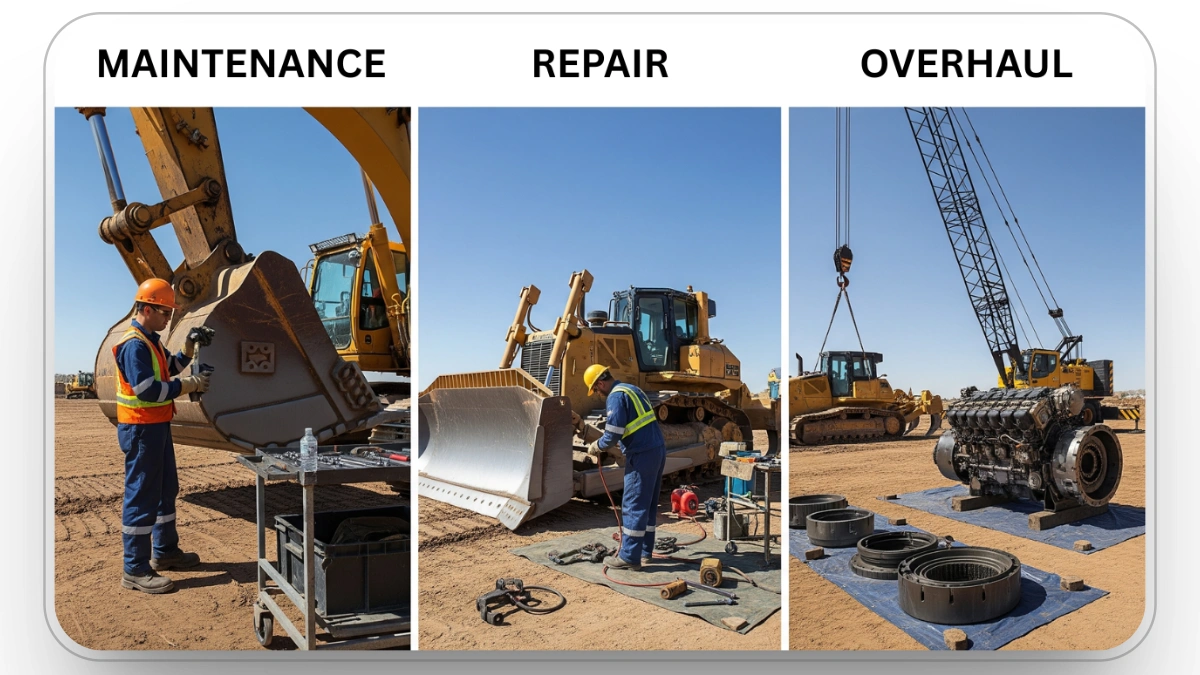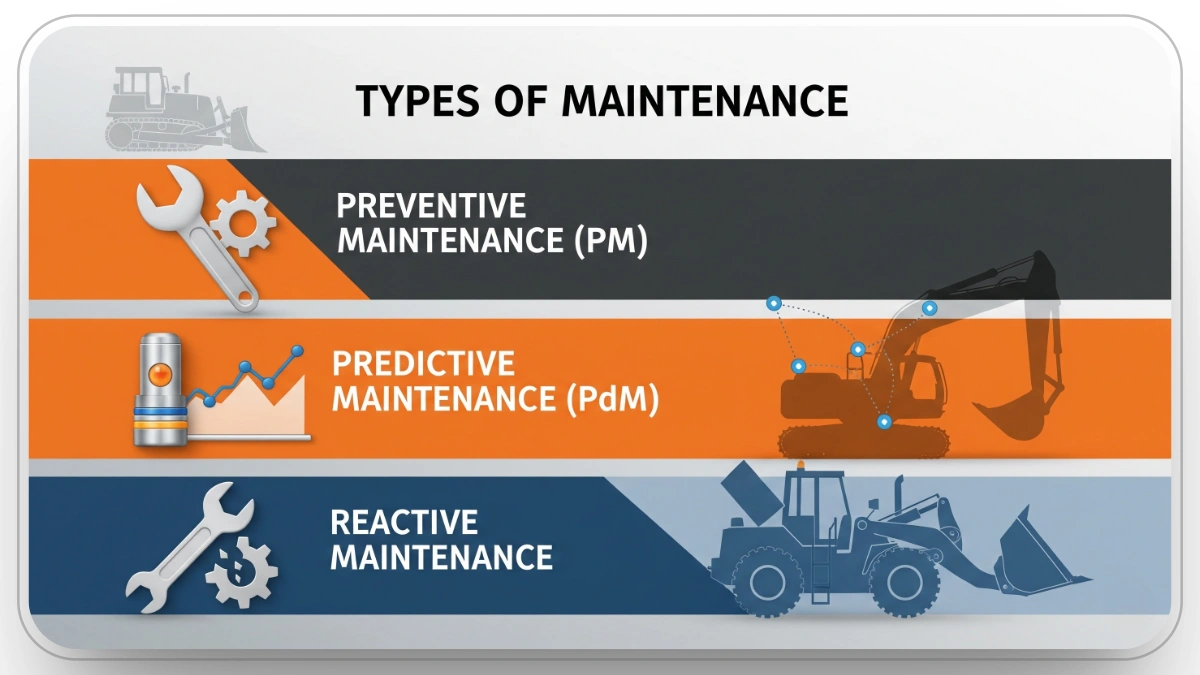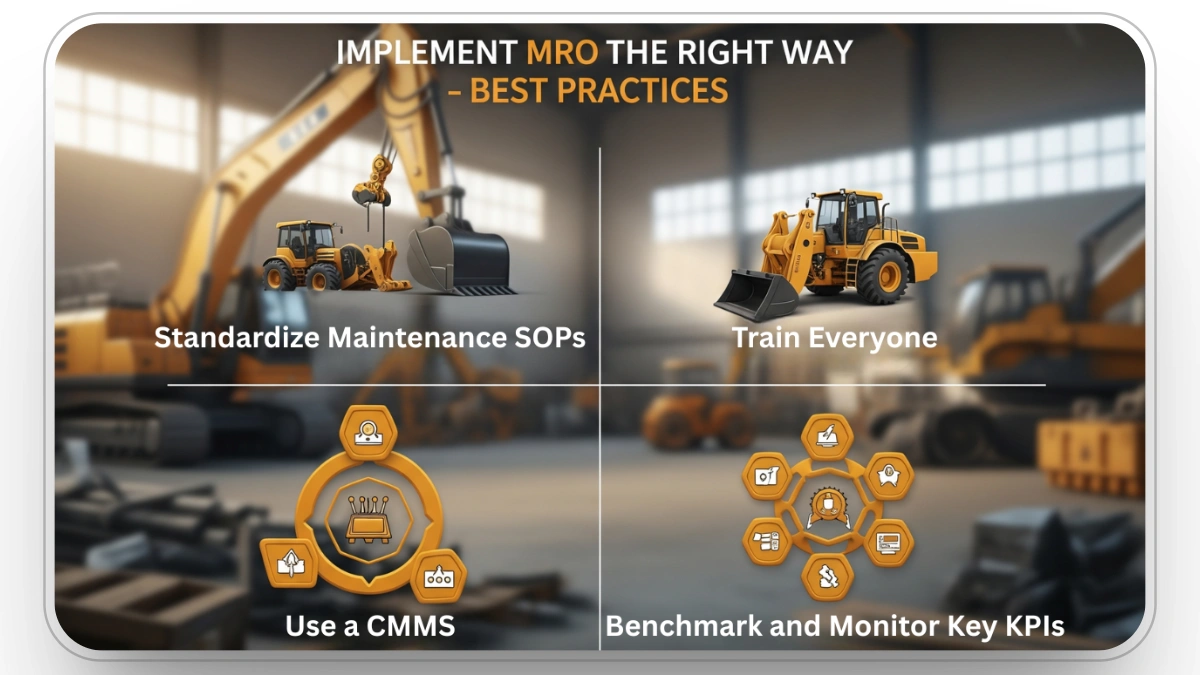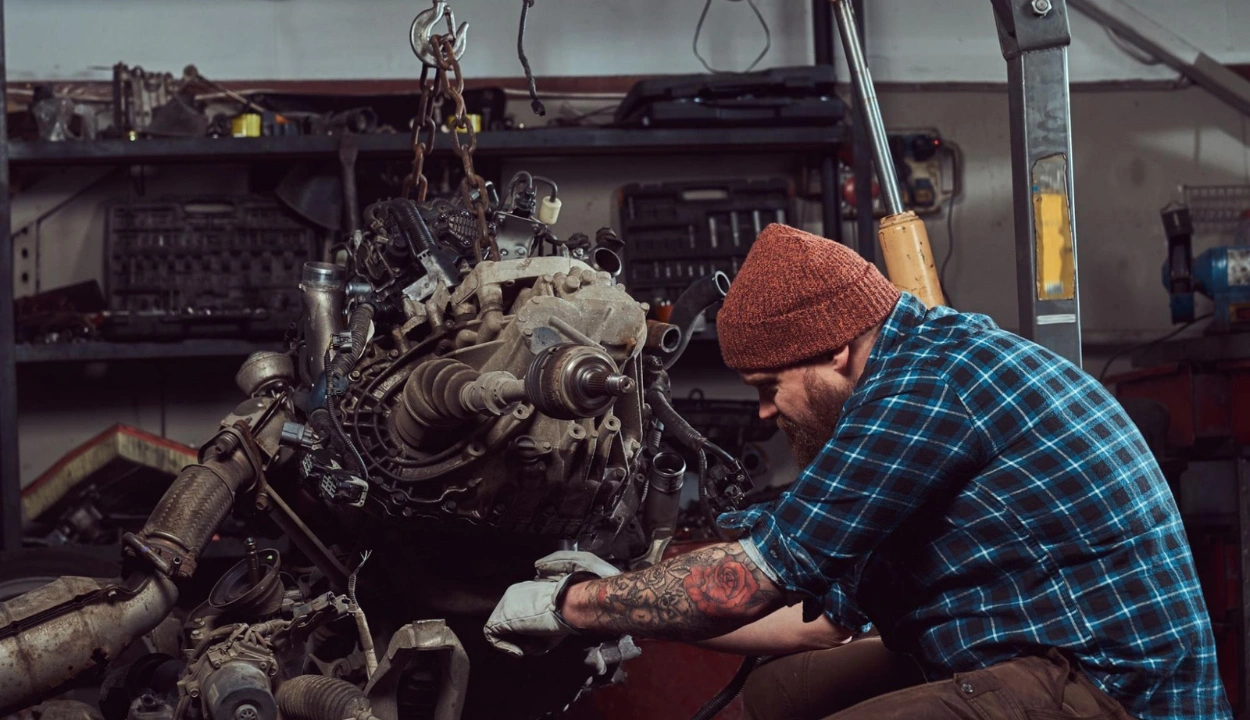What is Heavy Equipment Maintenance, Repair and Overhaul (MRO)
If you're managing construction projects, here’s what’s certain: your equipment will break, eventually. The question is how and when it will cost you. That is where Maintenance, Repair, and Overhaul (MRO) comes in as a lifesaver and not just a checklist.
Downtime is not a small hiccup in the construction process. It destroys efficiency, wrecks up your schedule and fiscally obliterates the budget. However, a smooth-running MRO organization does not simply involve reducing the amount of chaos, it involves being able to perform better, last longer, and complete projects with less hysteria.
Let us take this step by step, and understand it through data just enough to make your operation tight.
What is MRO?
Maintenance, Repair, and Overhaul (MRO) is a vital process that ensures the optimal performance and safety of equipment across its lifecycle. For the construction industry, MRO refers to all activities that maintain, fix, or restore heavy equipment like excavators, loaders, and concrete pumps.
In the construction industry, MRO refers to all planned and unplanned activities related to:
- Maintenance: Ongoing work to keep equipment in optimal condition
- Repair: Fixing failures when they happen
- Overhaul: Deep-level restoration or rebuild after long-term use
In this post, we’ll break down the three core pillars of MRO and show how these practices keep your equipment running smoothly and your projects on schedule.
The 3 Pillars of MRO

To be able to manage equipment, you must first understand how MRO can be broken down. In construction, all Maintenance, Repair, and Overhaul (MRO) strategies are constructed on three pillars that have specific functions in ensuring that machines are moving, are safe and productive.
Those pillars are not interchangeable, they exist as a cycle of proper upkeep. In the proper balance, they help get your fleet off the repair bay and back into the job.
1. Maintenance: The Proactive Approach
Maintenance is the proactive side of MRO. It refers to all scheduled actions you take to prevent failure and preserve the performance of heavy equipment over time. The goal isn’t just to reduce breakdowns, it’s to maintain fuel efficiency, safety, and predictable operational costs. Maintenance is your first line of defense.
It includes recurring tasks based on hours of usage, environmental exposure, and manufacturer recommendations.
Key Maintenance Tasks:
- Oil and filter changes
- Cleaning/replacing air and fuel filters
- Diagnostic system checks
Best Practices for Effective Maintenance:
- Adhere to OEM service intervals.
- Track engine hours (not calendar time) for service.
- Log every service action to create a reliable maintenance history.
- Train operators to perform daily checks and report abnormalities.
A machine that’s maintained doesn’t just last longer, it performs better every hour it runs.
2. Repair
Repair is reactive, it kicks in after something breaks. Even a well maintained machine will at one point require repairs especially when strained to perform in harsh conditions such as construction sites. Repair seeks to restore the functionality within a reasonable amount of time safely at minimal cost of downtime.
Repairs are of different levels, including simple adjustments and complete re-placing of the parts.
Common Repair Needs:
- Replacing hydraulic tubes
- Fixing overheated engines
- Resetting faulty sensors
The Impact of Delayed Repairs:
- Unplanned downtime
- Project delays
- Increased emergency part costs
Strong MRO systems aim to limit repair frequency by strengthening preventive practices. But when repairs are needed, quick diagnostics, stocked parts, and skilled techs are essential to getting machines back in the field.
3. Overhaul
Overhaul is the most comprehensive and capital-intensive layer of MRO. It’s not about fixing a single component. It’s about resetting the entire machine (or major subsystem) to near-new condition after extended service life. The purpose is simple: extend asset lifespan without buying new equipment.
An overhaul involves disassembling the equipment, evaluating core components, and replacing or rebuilding anything worn beyond spec.
This may include:
- Repairing or remanufacturing the engines, transmissions or differentials
- The conduction of frame checks or undercarriage checks
- Replacing new hydraulic pumps, cylinders or valves
- Reupholstering electrical harnesses, and replacing deteriorated electronics
Knowing when to overhaul is key.
When to overhaul:
- After 6,000 to 10,000 machine hours.
- When repair costs approach 50% of the asset’s replacement cost.
- As part of a planned asset lifecycle or pre-resale reconditioning program
Though overhauls are expensive and need substantial planning, they can extend the useful life of a machine by twice as long and offer good return on investment, and they do when there are limited resale prices or equipment availability.
What MRO Involves Beyond Repairs
MRO is also about inventory, planning, and process. Here’s what’s often overlooked:
MRO Inventory Management
Spare Parts:
- Starters, alternators, injectors
- Filters, belts, sensors
- Seals, fittings, gaskets
Consumables:
- Lubricants and grease
- Rags, gloves, solvents
- Hose clamps, zip ties, zip-locks
Diagnostic Tools:
- Pressure gauges
- Infrared thermometers
- Oil sampling kits
- Multimeters
Safety Gear:
- Lockout/tag kits
- Spill containment mats
- PPE: gloves, goggles, ear protection
Types of Maintenance

1. Preventive Maintenance (PM)
Preventive maintenance deals with being ahead of failure. It applies to planned work carried out at regular intervals and often on the basis of operating hours, calendar time or other manufacturer specifications. It is easy to understand the goal, detect small problems before they turn into substantial, expensive ones.
Common PM activities include:
- Changing engine oil and filters every 250 hours.
- Checking and topping off battery fluids monthly.
- Inspecting and cleaning air filters on a weekly basis.
- Washing down undercarriages after muddy jobs to prevent corrosion and buildup.
Benefits of Preventive Maintenance:
- Minimizes chances of catastrophic, on-site failures.
- Ensures areas covered in OEM warranties and safety regulations are adhered to.
- Simplifies budgeting by bringing certainty of what services cost.
2. Predictive Maintenance (PdM)
Predictive maintenance relies on real-time data and sensor feeds to establish when an element is approaching failure and it schedules for service before it fails. Rather than replace a part just because it’s “due” you replace it when the data says it’s problematically so. This approach will involve initial investment into technology and will reward itself in saved cost of the unnecessary service and maximized equipment reliability.
Typical tools used for predictive maintenance:
- Sensors on vibration that alert of the discrepancy on the moving parts.
- Sensors of oil quality examining levels of viscosity and contamination.
- Telematics with GPS that monitors hours, idling and operator behavior.
- Pressure sensors, temperature sensors to detect an abnormal system situation.
Benefits of Predictive Maintenance:
- The parts are replaced when it is actually necessary, wasting less.
- Averts unplanned failure without over maintenance.
- Increases the life of assets and reduces the total cost of ownership.
For high-value or high-usage equipment, PdM offers a smart path toward precision maintenance.
3. Reactive Maintenance
Also referred to as breakdown maintenance, reactive maintenance is done once something has already failed. It is the most basic method, get it to break and then fix, and it is the riskiest and the most costly option most of the time. Although it is not an ideal strategy tool per se, it is applicable in some situations.
Reactive maintenance can make sense when:
- The asset is low-cost and non-critical.
- The failure has minimal safety or schedule impact.
- Backup equipment is available and ready to go.
The best construction operations use reactive maintenance as a backup, not a business model.
Common MRO Challenges in Construction
Even with a solid MRO strategy, certain issues can derail operations if not proactively addressed.
Downtime Cost Spiral
- Even short delays hurt. A single failed machine can lead to.
- Idle crews waiting for equipment to return to service.
- Rental equipment delays pushing the schedule further.
- Penalties or client issues due to missed milestones.
- Overtime costs from trying to catch up.
- Rescheduling inspections or deliveries causing project-wide disruptions.
Parts Shortages
Without the right parts on hand, maintenance grinds to a halt:
- Missing high-failure parts like filters, hoses, or seals.
- Lack of OEM-specific components with long lead times.
- No emergency consumables like fluids or clamps when urgently needed.
- Rush shipping costs and cannibalizing machines become the fallback, both inefficient.
Documentation Gaps
If maintenance isn’t logged, it didn’t happen and it will cost you:
- Root causes go unresolved due to lack of history.
- Missed PM intervals increase breakdown risk.
- Lower resale value with no service records.
- Voided warranties from undocumented service timelines.
Implement MRO the Right Way with These Best Practices

Here’s how to put it all together so your maintenance strategy drives uptime, not overhead.
1. Standardize Maintenance SOPs
It is all about consistency in MRO. The use of Standard Operating Procedures (SOPs) enables all the technicians to work using the same playbook no matter what the job site or the shift. Clearly defined SOPs also decrease the human factor and make it safer.
What to Include in Your SOPs:
- Checklists that are box or machine specific (e.g. excavator vs skid steer).
- Classification of work in, daily, weekly, and monthly time periods.
- Infuse the right kind of fluid, fill sizes and torque specifications.
- The needed personal protective devices (PPE) concerning every maintenance procedure.
2. Train Everyone
Maintenance is team work. Operators, crews (especially the field team) and supervisory team are all involved in the process of determining the problems early and keeping machines healthy.
Training should ensure that:
- Operators know what normal vs. abnormal machine behavior looks like.
- Supervisors monitor usage hours and trigger maintenance on time.
- Maintenance leads document every service action and follow-up.
3. Use a CMMS (Computerized Maintenance Management System)
An effective CMMS converts maintenance into being strategic. It puts the center of your maintenance activities in view, control and automation on your side. Construction equipment maintenance software take this a step further by integrating real-time data, predictive analytics, and automated work order management into one streamlined platform.
Core Functions of a CMMS:
- Schedule preventive maintenance based on engine hours, not guesswork.
- Auto-generate and assign work orders.
- Track parts inventory and alert for low stock.
- Store detailed service history for each asset.
- Analyze asset performance and maintenance costs over time.
4. Benchmark and Monitor Key KPIs
What can’t be measured can’t be improved. Monitoring the appropriate maintenance KPIs assist you to optimize the performance, eliminate wastes and defend the budget requirements.
Essential MRO KPIs to Track:
- MTBF (Mean Time Between Failures).
- MTTR (Mean Time to Repair).
- Downtime per 1,000 hours.
- Maintenance cost as % of asset value.
Benchmarking these KPIs over time helps you spot trends and act before problems become costly failures.
Using Technology to Elevate MRO
Clue consolidates all your maintenance, repair and overhaul activities into a single system. Through OEM telematics, automation of work orders, and service history tracking, Clue helps you to be one step ahead of your equipment failure not behind it.
That means your team can be on top of it all with preventive alerts and real-time visibility to tasks and activities, so they can respond to an issue and make fewer trips to a machine.
Telematics
Telematics can facilitate a smoother MRO by giving warning signs in real time regarding equipment usage, engine hours, fuel consumption and fault codes, which can be used more effectively to anticipate when to schedule routine maintenance. It also enables remote diagnostics, which can enable maintenance crews to diagnose their systems earlier, and decrease unplanned downtimes.
Predictive Analytics with AI
Predictive analytics enables the use of AI-based algorithms to find trends in the data of the equipment and predict its failure in advance so that timely, specific work could be conducted. It minimizes over-servicing, substantially increases component life and cuts on-site repair costs.
- Analyze years of repair history.
- Forecast likely points of failure.
- Prioritize equipment for early intervention.
Mobile Work Order Apps
Mobile work order apps allow technicians to respond to, update and close out maintenance work directly in the field improving first response times and performance accountability. They also enable the teams to post photos, notes and parts being utilized in real time and thus accurate documentation which leads to improved communication between locations.
- Real-time status updates from field.
- Upload photos, flag issues, close out tickets on the go.
- Enables better communication between jobsite and maintenance hub.
Closing Thoughts
MRO is not merely break-to-fix, it is a carefully calculated means of ensuring that you not only safeguard your investments in equipment, but it is also a method of maximizing uptime, and meeting schedules and estimates without going over budget. Maintenance as an organized system and not a reactive task also favors the whole operation.
Your heavy equipment stops being a cost center and instead becomes a high-performance profit driver by standardizing its processes, training your staff, utilizing technology and undertaking upgrades proactively.
See how Clue can transform your maintenance operations.
Transform Your Equipment Management














